📚 Automation Examples
📋 Table of Contents
- Overview
- RabbitMQ Automation
- Kafka/Strimzi Automation
- FastAPI Automation
- k6 Load Testing Automation
- External Source Code Automation
- Image Base Automation
- Best Practices
- Additional Resources
Overview
This chapter provides real-world examples of service automation and relationships generated by Stacktic. These examples demonstrate how Stacktic automates configurations based on best-practice patterns, creating the necessary resources, documentation, and relationships to support full-stack demands.
Important Notes
⚠️ Scope Notice: These are examples only, not complete automation implementations.
The full automation is generated into your target repository's documentation with all configurations, secrets, and operational procedures.
What Gets Automated
| Service | Automated Components | Key Features |
|---|---|---|
| RabbitMQ | Exchanges, queues, bindings, users | Message flow configuration |
| Kafka | Topics, bridges, connectors, sinks | Event streaming setup |
| FastAPI | Routes, endpoints, documentation | API gateway integration |
| k6 | Test scripts, CRDs, plugins | Performance testing |
| External Source | Git integration, CI/CD, deployments | Automated builds from source |
| Image Base | Pre-built deployments, init containers | Direct image deployment |
🐇 RabbitMQ Automation
Component Architecture
RabbitMQ automation demonstrates how Stacktic handles message queue patterns with sub-components and relationships.
Sub-Component Creation
You can create sub-components such as:
- Exchanges - Message routing logic
- Queues - Message storage
- Bindings - Flow definitions between exchanges and queues
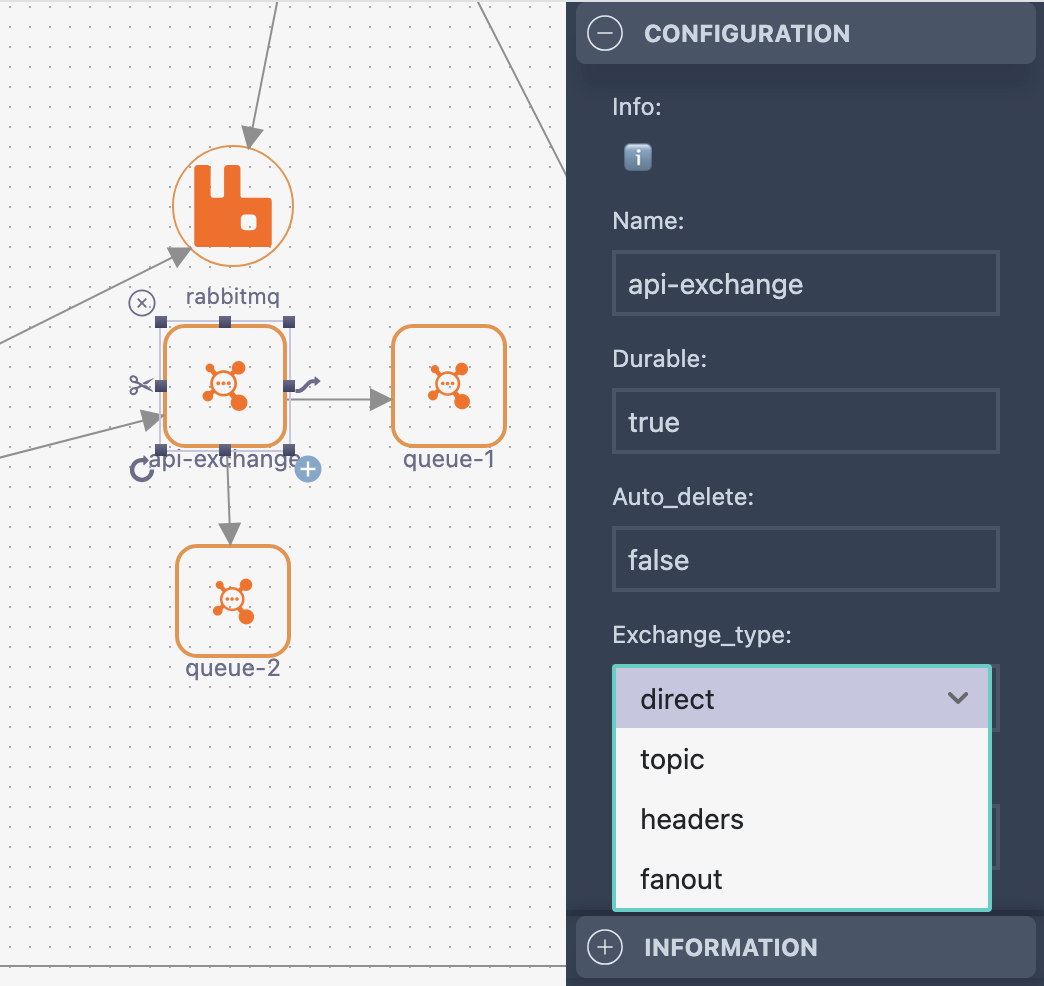
Relationship Configuration
The link between an exchange and a queue represents the binding configuration:
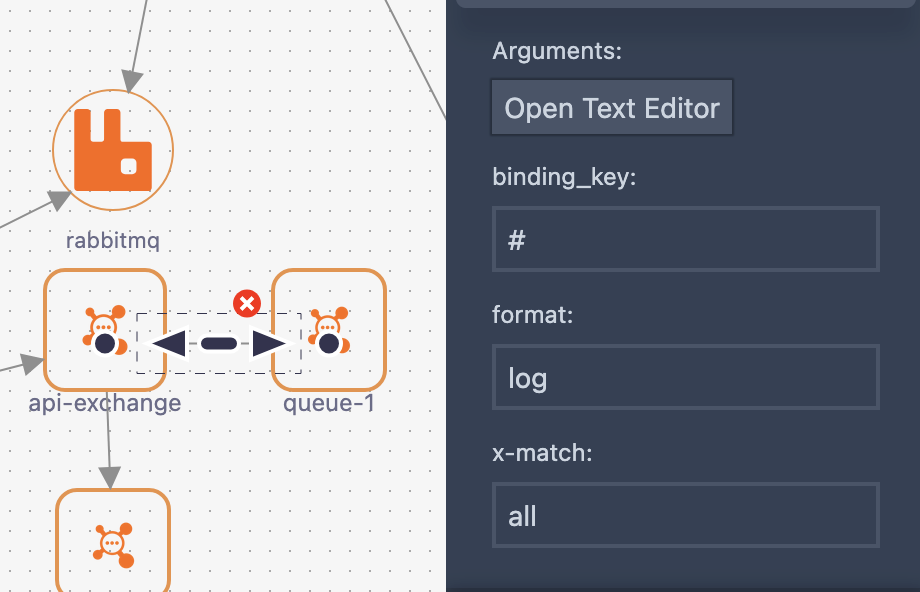
Generated Configuration
Secret Configuration Example
The automation generates a complete RabbitMQ configuration stored as a Kubernetes secret:
cat k8s/deploy/base/rabbitmq/secret/definitions.json
{
"vhosts": [
{ "name": "/" }
],
"users": [
{
"name": "user",
"password_hash": "EJBKv6SgKs6UFaLurzia3tPUIxQ/d4NIfwXG0OUWD2ayoCRd",
"tags": "management"
},
{
"name": "admin",
"password_hash": "C5pNaWoy+Fb7WeHsIgtP/6DvaimpRJkdo4BQQYlO+yluv0b/",
"tags": "administrator"
}
],
"permissions": [
{ "user": "user", "vhost": "/", "configure": ".*", "write": ".*", "read": ".*" },
{ "user": "admin", "vhost": "/", "configure": ".*", "write": ".*", "read": ".*" }
],
"parameters": [],
"global_parameters": [
{ "name": "cluster_name", "value": "rabbit@my-rabbit" }
],
"policies": [],
"bindings": [{
"source": "api-system",
"destination": "systems",
"destination_type": "queue",
"vhost": "/",
"routing_key": "#"
}],
"queues": [{
"name": "systems",
"vhost": "/",
"durable": true,
"auto_delete": false,
"arguments": {}
}],
"exchanges": [{
"name": "api-system",
"type": "topic",
"vhost": "/",
"durable": true,
"auto_delete": false,
"internal": false,
"arguments": {}
}]
}
Additional Configurations
| Configuration Type | Location | Purpose |
|---|---|---|
| Versioning | Component level | RabbitMQ version management |
| Resources | Component attributes | CPU/Memory allocation |
| Security | Component & links | Authentication, TLS, network policies |
| Monitoring | Auto-generated | Prometheus metrics, Grafana dashboards |
📝 Note: Additional configuration related to versioning, resources, and security exists within the RabbitMQ component itself.
🦄 Kafka Automation
Advanced Event Streaming
Kafka Strimzi is a more complex component but follows similar automation principles.
Sub-Component Types
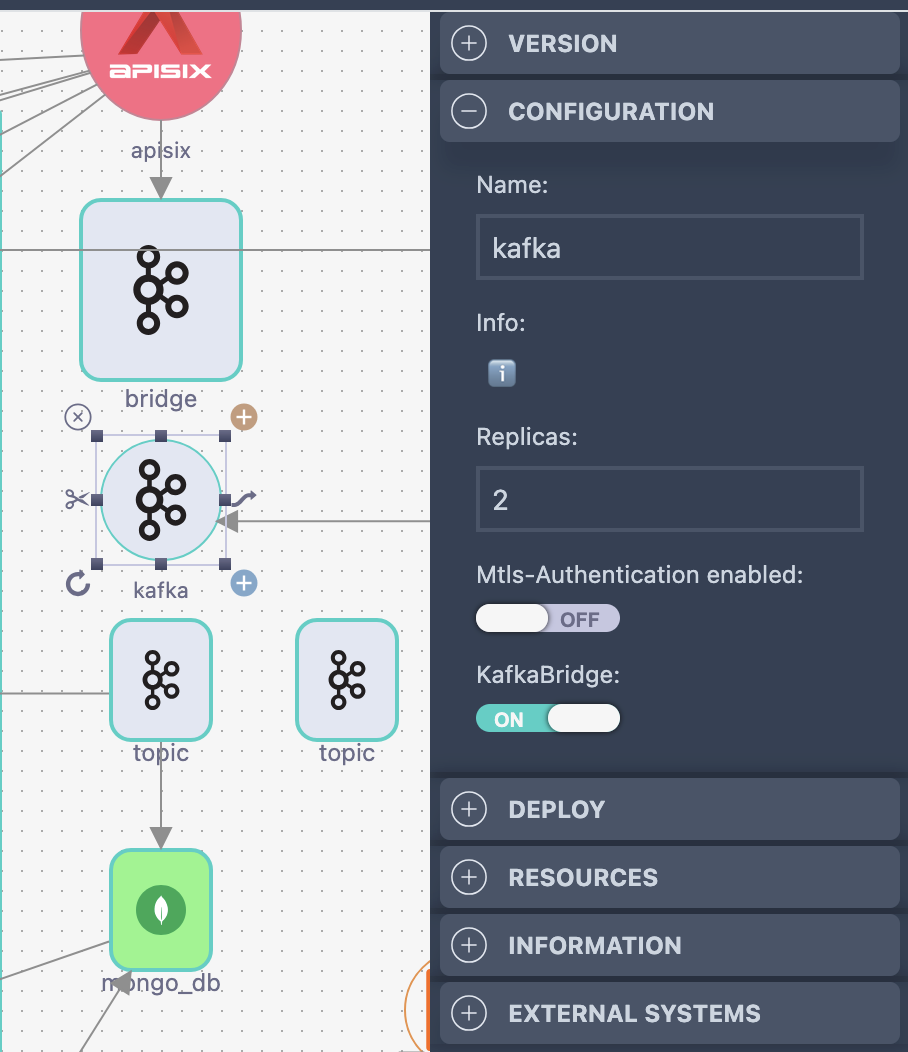
| Sub-Component | Purpose | Automation Features |
|---|---|---|
| Topics | Event streams | Partitions, replication, retention |
| Bridges | HTTP integration | REST API exposure |
| Connectors | External systems | Database sinks, source connectors |
| Users | Access control | ACLs, authentication |
Integration Capabilities
API Gateway Integration
- Bridge connects to API gateway
- Integrates with OIDC via Keycloak
- Automatic authentication setup
Database Integration
- Topic sub-components connect to databases for sink operations
- Automated Kafka Connect configuration
- End-to-end setup including connectors and secrets
Example Resources
Demo Repository
Explore a sample implementation (not full automation):
🔗 Basic Strimzi Setup
Connectors Example
Review automated connector configurations:
🔗 Kafka Connectors
Automated Components
| Component | Generated Assets |
|---|---|
| Kafka Cluster | StatefulSets, services, config |
| Kafka Connect | Deployment, connector definitions |
| Schema Registry | Deployment, schemas |
| Monitoring | JMX exporters, dashboards |
⚡ FastAPI Automation
API Development Acceleration
FastAPI automation streamlines API configuration and documentation through intelligent relationship management.
Automatic Configuration
When you connect FastAPI to a queue or database, Stacktic automatically:
| Action | Generated Assets |
|---|---|
| Adds dependencies | Python packages, requirements.txt |
| Configures routes | API endpoints, middleware |
| Creates services | Business logic templates |
| Generates endpoints | GET, POST, DELETE, PUT methods |
| Documents APIs | OpenAPI/Swagger specs |
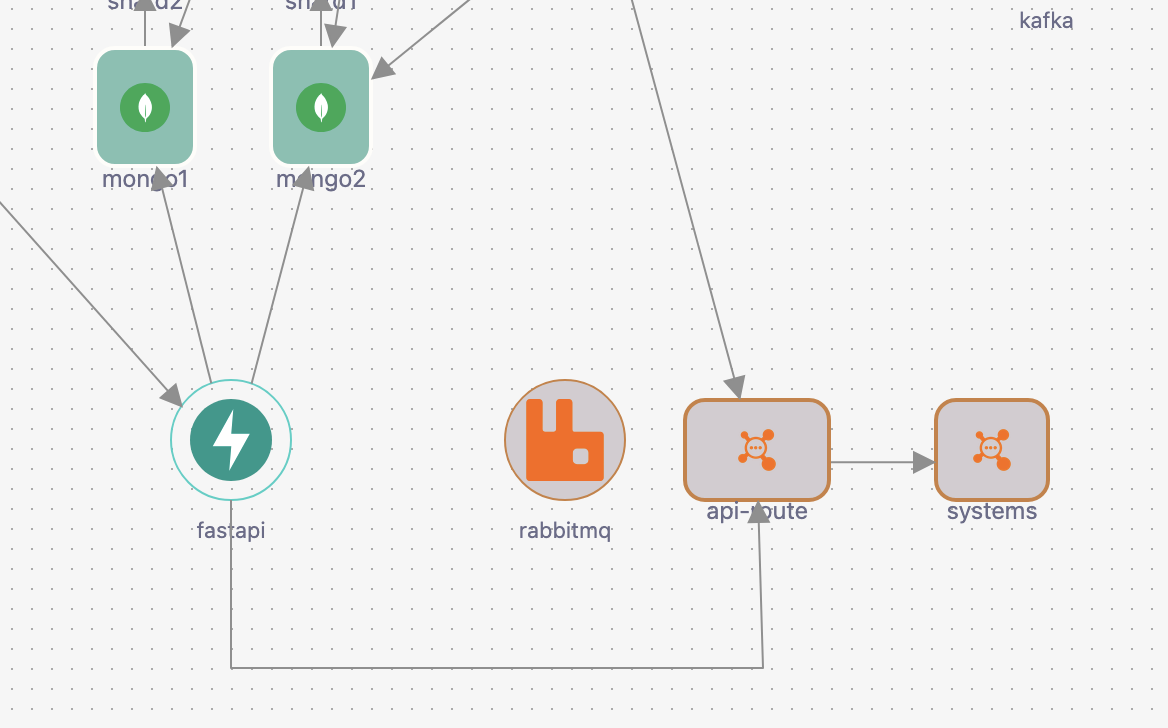
API Gateway Integration
Connect FastAPI to APISIX API Gateway for production-ready deployment:
- Automatic route registration
- Load balancing configuration
- Health check setup
- Rate limiting rules
Validation & Testing
Validate the configuration by testing the FastAPI endpoints and viewing generated documentation:
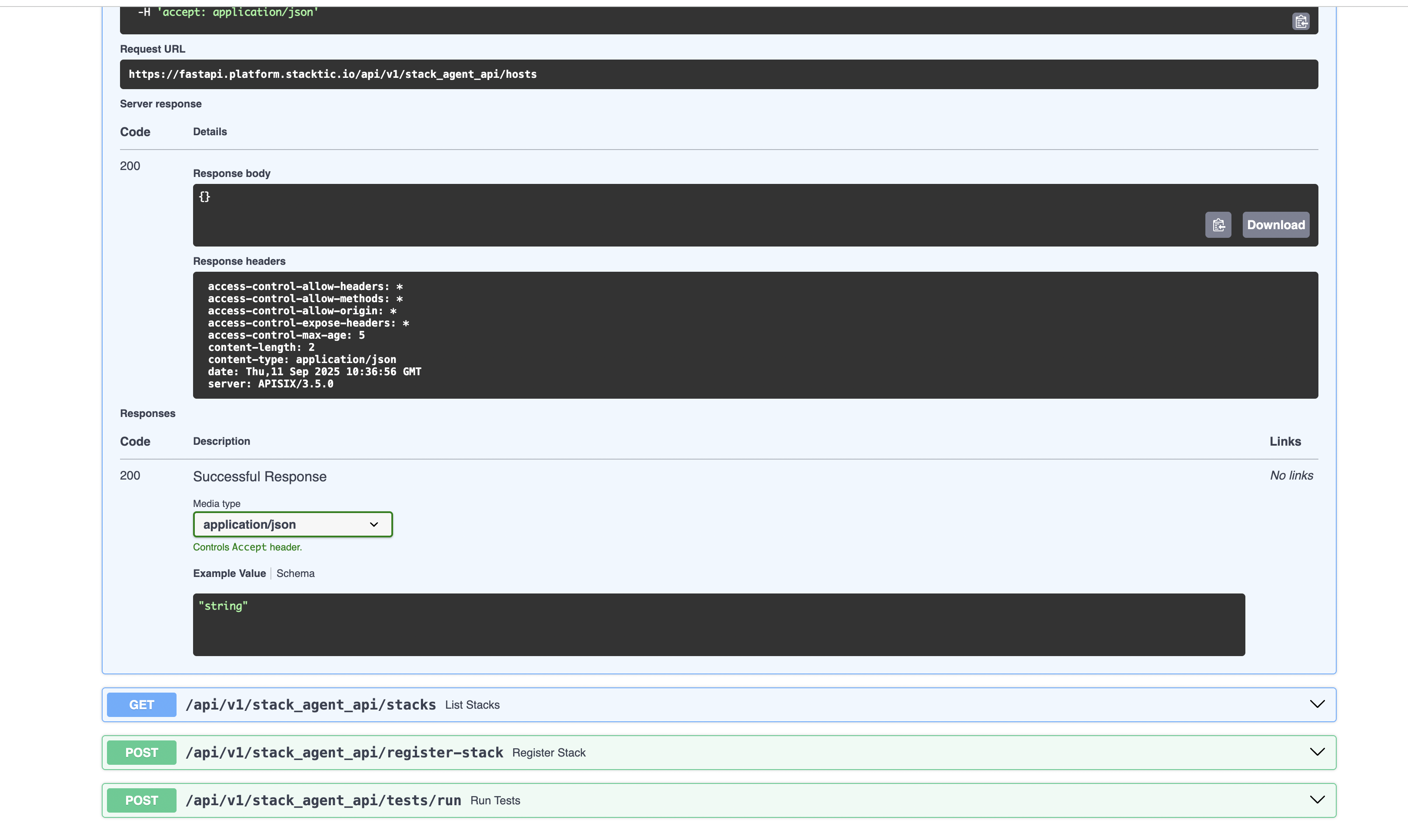
sub_component for custom API
Stacktic acts as version control for your stack.
You can:
- Create your own API on the existing FastAPI service in the
mainbranch. - Modify an existing API.
- Or use sub-components to define APIs.
When you add a sub-component, Stacktic automatically generates the API code inside the existing structure.
You don't need to manually touch main—just add the route and basic service definition.
✅ Advantages of Using Sub-Component APIs
- Saved as part of Stacktic's version control, making it easy to track changes.
- Minimizes direct code editing—no need to manage dependencies or modify
main; simply provide the API definition. - Gives Stacktic additional metadata about your logic, enabling smarter automation and insights.

Security Best Practices
🔒 Security Recommendation:
We recommend external authentication instead of relying solely on FastAPI's built-in API key system.
OIDC Integration with APISIX & Keycloak
Use APISIX and Keycloak for enterprise-grade authentication:
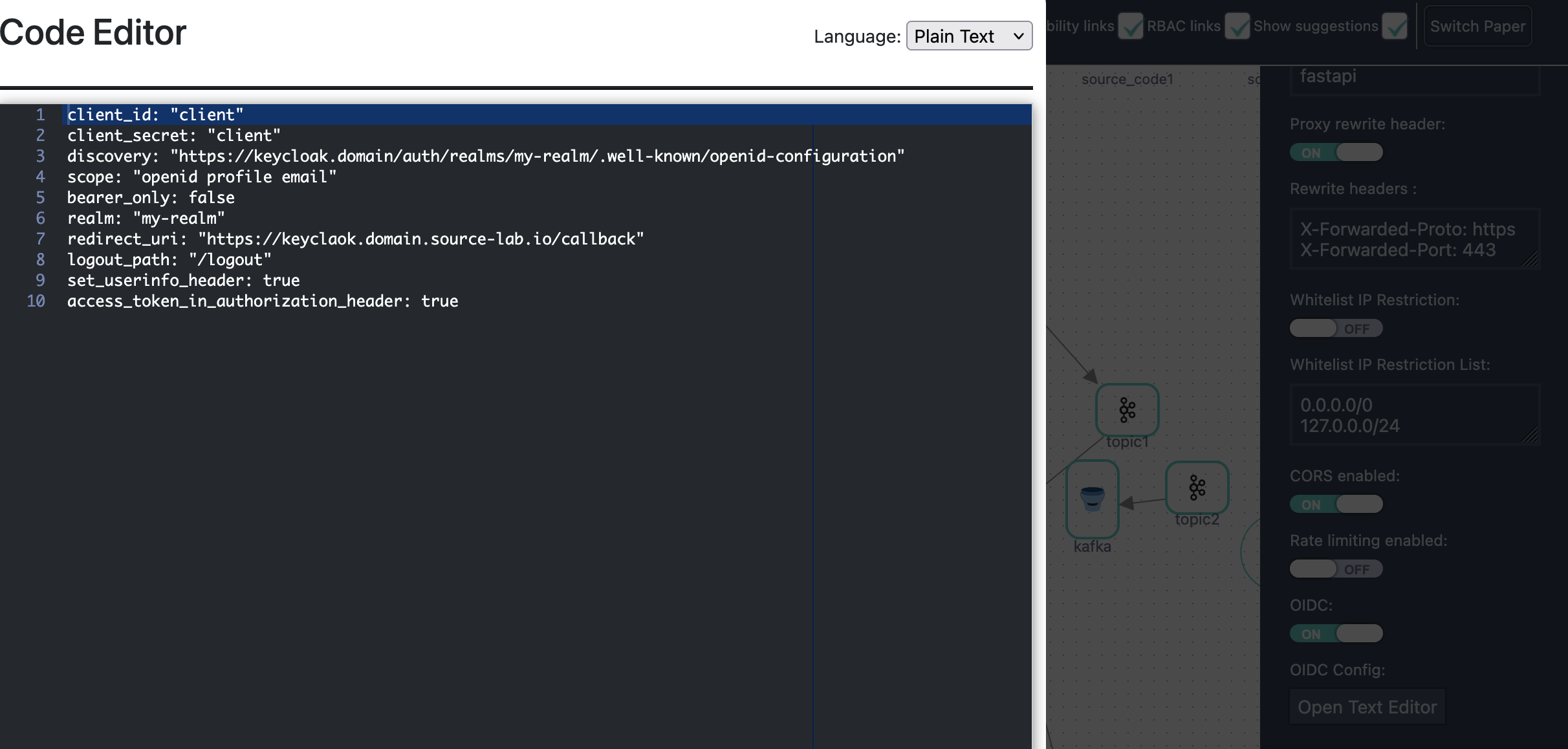
Benefits:
- ✅ Centralized authentication
- ✅ OIDC/OAuth2 support
- ✅ Single Sign-On (SSO)
- ✅ Token-based security
- ✅ Role-based access control
Configuration Details
| Configuration | Level | Description |
|---|---|---|
| Versioning | Component | Python version, FastAPI version |
| Admin Credentials | Component | Initial admin setup |
| Resources | Component | CPU/Memory limits |
| Build Image | Link | Required when linking APIs |
💡 Build Note: Build image is required when linking APIs to ensure dependency compatibility.
📈 k6 Load Testing Automation
Performance Testing Framework
To quickly assess your stack's performance and scaling configuration, link k6 to any service component.
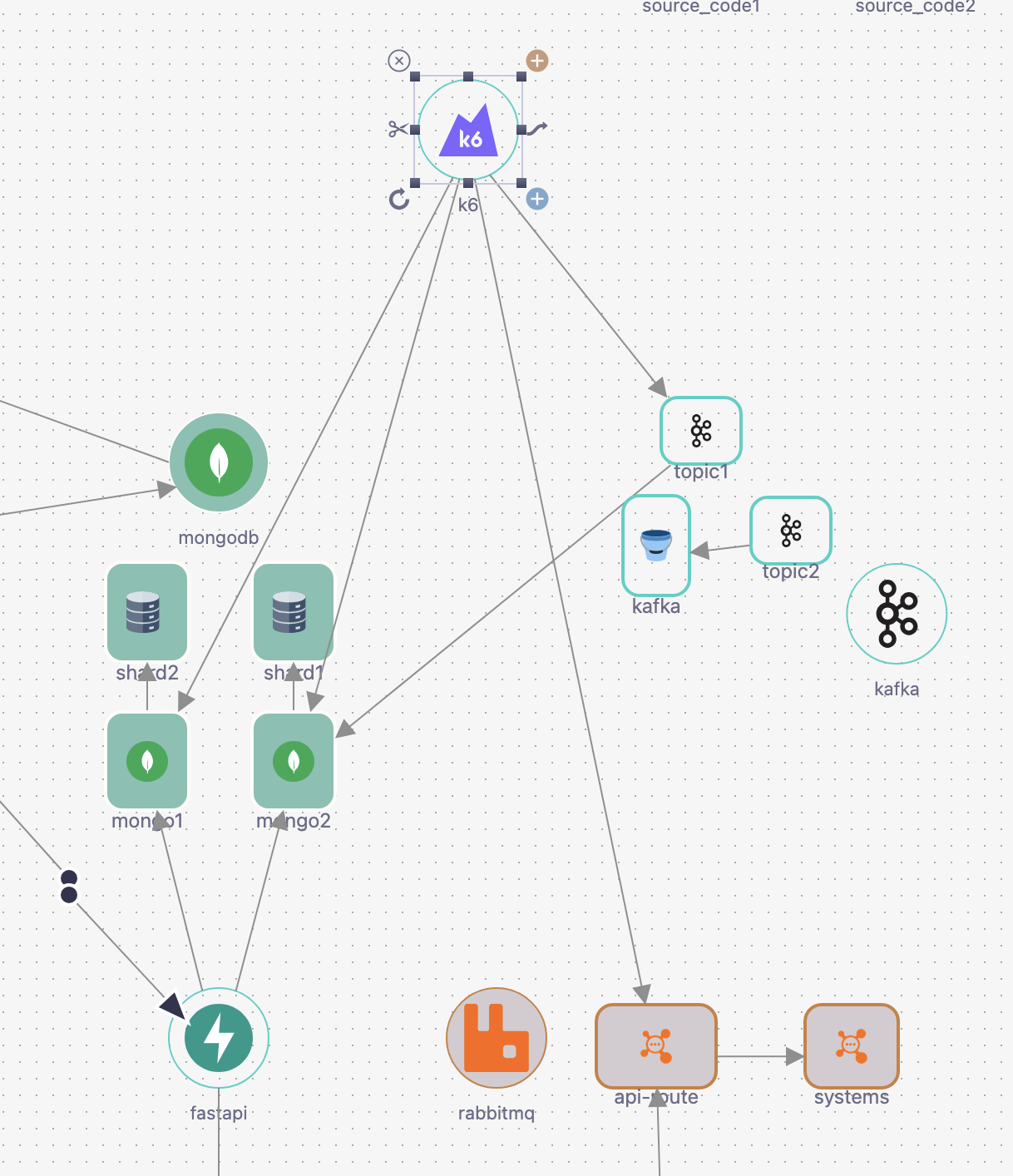
Automated Test Generation
When k6 is linked to services, Stacktic automatically:
| Action | Generated Output |
|---|---|
| Creates test files | k6 JavaScript test scripts |
| Builds CRDs | Kubernetes custom resources |
| Configures plugins | Database, queue, API plugins |
| Sets up reporting | Metrics collection, dashboards |
Example k6 Structure
tree k8s/deploy/base/k6
k8s/deploy/base/k6
├── k6.yaml # k6 operator configuration
├── kustomization.yaml # Kustomize manifest
├── mongodb_collector.yaml # MongoDB metrics collector
├── namespace.yaml # k6 namespace
├── secret
│ ├── cloud.env # Cloud configuration
│ └── registry.json # Registry credentials
├── test-run.yaml # Test execution definitions
└── tests
├── cnpg.js # PostgreSQL tests
├── kafka.js # Kafka tests
├── mongo.js # MongoDB tests
├── psql.js # PostgreSQL tests
└── rabbitmq.js # RabbitMQ tests
Test Execution Configuration
Sample test-run.yaml
apiVersion: k6.io/v1alpha1
kind: TestRun
metadata:
name: mongo-test
namespace: k6-operator-system
spec:
parallelism: 1
paused: "false"
quiet: "false"
script:
configMap:
name: k6-test-scripts
file: mongo.js
runner:
image: index.docker.io/asauer/k6:0.0.1-SNAPSHOT
imagePullSecrets:
- name: registry-credential
envFrom:
- secretRef:
name: k6-cm
resources:
limits:
cpu: 1000m
memory: 1Gi
requests:
cpu: 250m
memory: 256Mi
---
apiVersion: k6.io/v1alpha1
kind: TestRun
metadata:
name: rabbitmq-test
namespace: k6-operator-system
spec:
parallelism: 1
paused: "false"
quiet: "false"
script:
configMap:
name: k6-test-scripts
file: rabbitmq.js
runner:
image: index.docker.io/asauer/k6:0.0.1-SNAPSHOT
imagePullSecrets:
- name: registry-credential
envFrom:
- secretRef:
name: k6-cm
resources:
limits:
cpu: 1000m
memory: 1Gi
requests:
cpu: 250m
memory: 256Mi
Loading your full stack with single JSON
Add Sub_componenets Endpoints
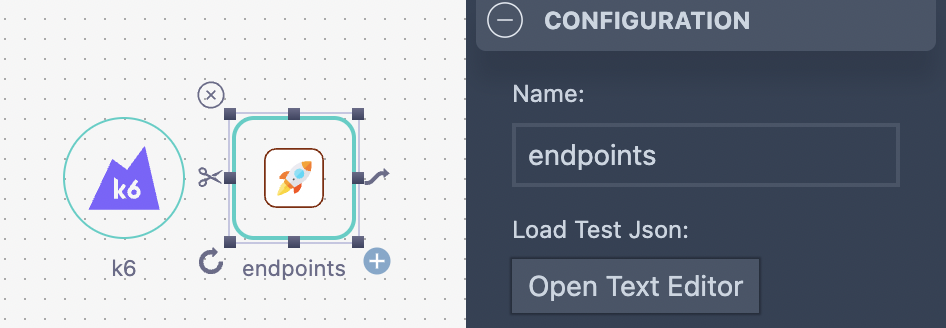
enter your json URL to the "Load Test Json" attribute. for example:
[
{
"url": "https://prod.stack.source-lab.io/",
"insecure": true
},
{
"url": "https://dev.stack.source-lab.io/",
"insecure": true,
"method": "POST",
"payload": {"key": "value"}
},
{
"url": "https://secure-endpoint.com",
"insecure": false
}
]
Execute the tests (k8s/deploy/base/k6/test-run.yaml)
kubectl logs endpoints-test-1-4p7ff -n k6-operator-system
/\ Grafana /‾‾/
/\ / \ |\ __ / /
/ \/ \ | |/ / / ‾‾\
/ \ | ( | (‾) |
/ __________ \ |_|\_\ \_____/
execution: local
script: /test/generic-test.js
output: -
scenarios: (100.00%) 1 scenario, 1 max VUs, 10m30s max duration (incl. graceful stop):
* default: 1 iterations for each of 1 VUs (maxDuration: 10m0s, gracefulStop: 30s)
█ TOTAL RESULTS
checks_total.......: 1 6.352779/s
checks_succeeded...: 100.00% 1 out of 1
checks_failed......: 0.00% 0 out of 1
✓ status OK
HTTP
http_req_duration..............: avg=26.3ms min=26.3ms med=26.3ms max=26.3ms p(90)=26.3ms p(95)=26.3ms
{ expected_response:true }...: avg=26.3ms min=26.3ms med=26.3ms max=26.3ms p(90)=26.3ms p(95)=26.3ms
http_req_failed................: 0.00% 0 out of 1
http_reqs......................: 1 6.352779/s
EXECUTION
iteration_duration.............: avg=157.29ms min=157.29ms med=157.29ms max=157.29ms p(90)=157.29ms p(95)=157.29ms
iterations.....................: 1 6.352779/s
NETWORK
data_received..................: 3.7 kB 24 kB/s
data_sent......................: 1.7 kB 11 kB/s
Performance Testing Benefits
| Feature | Benefit |
|---|---|
| Automated test creation | Tests generated from topology |
| One-time image build | Reusable across all tests |
| Integrated reporting | Results in Grafana dashboards |
| Scaling validation | Verify autoscaling configurations |
📊 Pro Tip: You only need to build the k6 image once—test definitions are referenced directly in the deployment through ConfigMaps.
🔧 External Source Code Automation
Export Code to automate CI & CD
External Source Code automation enables ** integration of existing codebases** with automated build and deployment pipelines.
Component Configuration
When creating an External Source Code component, Stacktic automatically:
| Action | Generated Assets |
|---|---|
| Configures Git integration | Git credentials, branch management |
| Sets up build pipeline | Kaniko jobs, Dockerfile processing |
| Creates deployments | Kubernetes manifests, services |
| Manages secrets | Registry credentials, environment variables |
| Implements security | RBAC, service accounts, security contexts |
Quick setup
Configuration Tips: Define your Git Repository
Configmap: make sure to add ENV needed for the container code to come up
Docker_file_path: default is "/". if you move Dockerfiel , please update the path
Git_folder: same as above. build expect root sturcture where Dockerfile is in the root , src folder,etc...
UID/GID: make sure the UID/GID match the Dockerfile
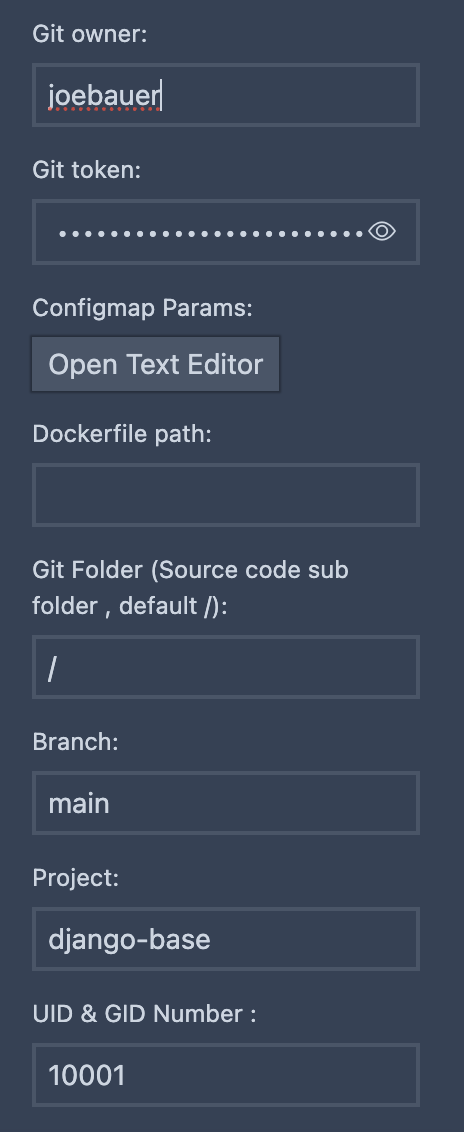
Deployment Tips
Rarget port: should be identical to the Dockerfile port
Pvc mount path: if PVC enabled make sure it fit your code path
mount file folder: if you want to add from deployment level files to the container and mount it to PVC
configMapGenerator:
- name: staging-static-files
namespace: staging
files:
- files/test_file.text
options:
disableNameSuffixHash: true
- name: staging-startup
namespace: staging
files:
- files/startup.sh
options:
disableNameSuffixHash: true
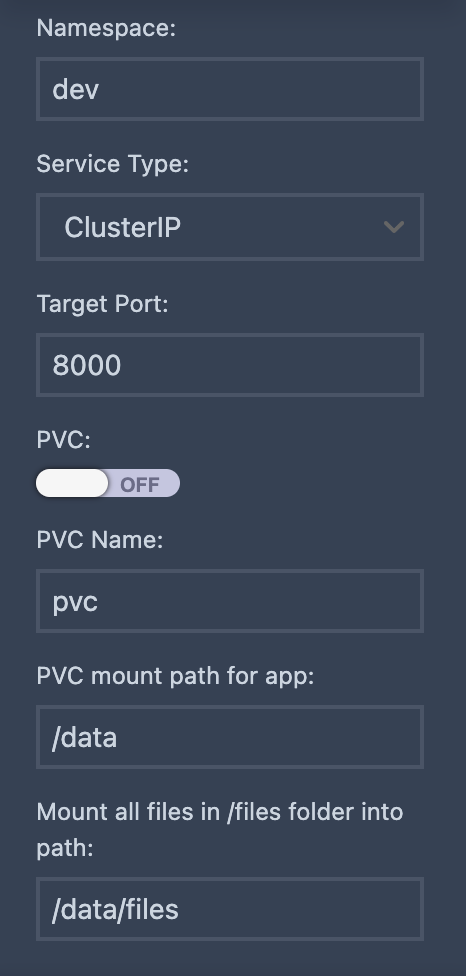
Kaniko Build Process
The automation generates a complete CI using Kaniko or buildkit for containerless builds:

k8s/build/base/stage/buildkit.yaml
or
k8s/build/base/stage/kaniko.yaml
Configuration Options
| Configuration | Purpose | Automation Impact |
|---|---|---|
| Git Owner | Repository owner | Determines Git URL construction |
| Project | Repository name | Sets build context |
| Branch | Target branch | Controls source version |
| Git Folder | Subdirectory path | Sets context sub-path |
| Dockerfile | Custom Dockerfile path | Optional build customization |
| Version | Image tag | Deployment version control |
| Registry | Container registry | Build destination |
| Namespace | Kubernetes namespace | Deployment location |
Security Features
Pod Security Standards
When security context is enabled, the deployment automatically implements:
spec:
securityContext:
runAsNonRoot: true
runAsUser: 1000 # Configurable user ID
runAsGroup: 1000 # Configurable group ID
seccompProfile:
type: RuntimeDefault
hostNetwork: false
hostPID: false
hostIPC: false
containers:
- securityContext:
allowPrivilegeEscalation: false
privileged: false
readOnlyRootFilesystem: true
capabilities:
drop: [ALL]
Supply Chain Security
When signature validation (sig) is enabled:
- Cosign integration for image signing
- Signature verification jobs
- RBAC policies for validation
- Key management through Kubernetes secrets
- Automated validation on deployment
Advanced Features
| Feature | Configuration | Generated Components |
|---|---|---|
| Auto-scaling | hpa: true | HorizontalPodAutoscaler resources |
| Persistent storage | pvc: true | PersistentVolumeClaim manifests |
| Monitoring | Prometheus integration | ServiceMonitor resources |
| Image updates | imageupdater_update_enable: true | Automatic version tracking |
| Static files | files_mount_path | ConfigMap with mounted files |
| Health checks | probes: true | Liveness/Readiness probe patches |
| Ingress | Kong integration | Ingress rules and routes |
Resource Management
Flexible resource configuration with defaults:
resources:
requests:
cpu: "1000m"
memory: "512Mi"
limits:
cpu: "2000m"
memory: "1024Mi"
Volume Management
| Volume Type | Use Case | Configuration |
|---|---|---|
| PVC | Persistent data | pvc_name, mount_path |
| EmptyDir | Temporary storage | /tmp, writable directories |
| ConfigMap | Static files | Read-only file mounts |
| Secrets | Sensitive data | Environment variables |
Build Process Options
| Build Feature | Description | Configuration |
|---|---|---|
| SonarQube | Code quality analysis | Automated scanning |
| Multi-stage builds | Optimized images | Dockerfile support |
| Build caching | Faster builds | Layer caching |
| Custom base images | Corporate standards | Registry configuration |
🐳 Image Base Automation
Pre-Built Image Deployment
Image Base automation provides streamlined deployment of existing container images without requiring source code access.
Component Architecture
Image Base components support deployment of any containerized application with automated configuration:
| Component | Automated Features |
|---|---|
| Init Containers | Startup scripts, initialization logic |
| Main Container | Application deployment |
| Startup Scripts | Custom initialization via ConfigMap |
| Security Policies | Pod and container security contexts |
| Service Accounts | RBAC and permissions |
Startup Automation
Init Container Configuration
The automation includes sophisticated initialization capabilities:
initContainers:
- name: startup
image: application-image:version
command: ["/bin/sh", "-c"]
args: ["/startup/startup.sh"]
resources:
requests:
cpu: 100m
memory: 128Mi
limits:
cpu: 200m
memory: 256Mi
envFrom:
- secretRef:
name: component-external-source-secrets
volumeMounts:
- mountPath: /startup
name: startup-scripts
readOnly: true
- mountPath: /tmp
name: tmp-volume
Configuration Management
Startup Script Integration
Automatically mounts custom startup scripts via ConfigMap:
configMapGenerator:
- name: component-startup
namespace: namespace
files:
- files/startup.sh
options:
disableNameSuffixHash: true
Image Management Features
| Feature | Configuration | Benefit |
|---|---|---|
| Direct image deployment | Image URL/tag | No build required |
| Version control | version attribute | Consistent deployments |
| Registry authentication | Pull secrets | Private registry support |
| Update automation | imageupdater_update_enable | Automatic version updates |
| Multi-registry support | Registry configuration | Flexibility in image sources |
Resource Allocation
Flexible resource configuration with separate init container limits:
# Init Container Resources
initContainers:
- resources:
requests: {cpu: 100m, memory: 128Mi}
limits: {cpu: 200m, memory: 256Mi}
# Main Container Resources
containers:
- resources:
requests:
cpu: "{{ cpu_request }}"
memory: "{{ mem_request }}"
limits:
cpu: "{{ cpu_limit }}"
memory: "{{ mem_limit }}"
Security Implementation
Multi-Level Security
Both pod-level and container-level security contexts:
# Pod Level Security (when pod_level_security: true)
spec:
securityContext:
runAsNonRoot: true
runAsUser: 1000 # Configurable
runAsGroup: 1000 # Configurable
seccompProfile:
type: RuntimeDefault
hostNetwork: false
hostPID: false
hostIPC: false
# Container Level Security (when securityContext: true)
containers:
- securityContext:
allowPrivilegeEscalation: false
privileged: false
readOnlyRootFilesystem: true
runAsNonRoot: true
capabilities:
drop: [ALL]
Deployment Patterns
| Pattern | Implementation | Use Case |
|---|---|---|
| Init + Main | Startup container + app | Database migrations, config setup |
| Sidecar Ready | Multiple container support | Logging, monitoring agents |
| StatefulSet Compatible | PVC integration | Databases, stateful services |
| Job Pattern | One-time execution | Batch processing, migrations |
| DaemonSet Ready | Node-level deployments | System agents, monitoring |
Monitoring & Observability
When Prometheus is configured:
- Automatic ServiceMonitor creation
- Metrics endpoint configuration
- Namespace-aware monitoring
- Standard Kubernetes labels
- Custom metrics path support
Advanced Configurations
| Configuration | Purpose | Generated Resources |
|---|---|---|
| Affinity Rules | Pod distribution | Anti-affinity policies |
| Service Types | Network exposure | ClusterIP, NodePort, LoadBalancer |
| Ingress Integration | External access | Kong ingress rules |
| Cosign Validation | Image verification | Signature check jobs |
| Image Pull Secrets | Private registries | Docker config secrets |
| Service Account | RBAC permissions | Roles and bindings |
Comparison: External Source vs Image Base
| Aspect | External Source Code | Image Base |
|---|---|---|
| Build Process | Kaniko from source | Pre-built images |
| Startup Logic | In Dockerfile | Init containers |
| Flexibility | Full source control | Image-level control |
| Speed | Build + deploy | Deploy only |
| Use Case | Custom applications | Third-party/pre-built apps |
| Git Integration | Required | Not needed |
| CI/CD Pipeline | Full automation | Deployment only |
| Resource Usage | Build resources needed | Deployment resources only |
Secret Management
Both automation types handle secrets securely:
secretGenerator:
- name: registry-credential
namespace: namespace
files:
- .dockerconfigjson=secret/registry.json
type: kubernetes.io/dockerconfigjson
- name: component-external-source-secrets
namespace: namespace
envs:
- secret/cloud.env
- name: component-cosign-key-secret
namespace: namespace
files:
- secret/cosign/cosign.key
- secret/cosign/cosign.pub
- secret/cosign/password
📚 Best Practices
General Automation Guidelines
| Practice | Description | Benefit |
|---|---|---|
| Start Simple | Begin with basic components | Easier troubleshooting |
| Use Sub-Components | Leverage hierarchical structure | Better organization |
| Define Relationships | Connect components properly | Automatic configuration |
| Test in Stages | Dev → Staging → Production | Risk mitigation |
| Review Generated Docs | Check automation outputs | Understanding & validation |
| Version Everything | Tag images and code | Rollback capability |
| Use Security Contexts | Enable pod/container security | Defense in depth |
Security Recommendations
- External Authentication - Use OIDC providers over built-in auth
- Secret Management - Let Stacktic handle secret generation
- Network Policies - Enable auto-generated policies
- TLS Everywhere - Use encrypted connections
- Regular Updates - Keep component versions current
- Image Signing - Enable Cosign for supply chain security
- RBAC - Use service accounts with minimal permissions
Performance Optimization
- ✅ Use k6 for baseline performance testing
- ✅ Configure resource limits appropriately
- ✅ Enable horizontal pod autoscaling
- ✅ Implement caching strategies
- ✅ Monitor with Prometheus/Grafana
- ✅ Use init containers for one-time setup
- ✅ Optimize image sizes
🎯 Summary
Key Takeaways
✅ Pattern-Based Automation - Best practices built into every component
✅ Relationship Intelligence - Connections drive configuration
✅ Complete Stack Coverage - From messaging to testing
✅ Security by Default - Authentication, encryption, policies
✅ Production Ready - Generated configurations are deployment-ready
✅ Flexible Deployment - Support for both source code and pre-built images
✅ GitOps Native - All configurations in Git-friendly formats
What's Automated vs. What You Control
| Stacktic Automates | You Control |
|---|---|
| Infrastructure configuration | Business logic |
| Service connections | Application code |
| Security policies | Data schemas |
| Monitoring setup | Business rules |
| Testing frameworks | Custom algorithms |
| Build pipelines | Source code |
| Deployment manifests | Configuration values |
These examples demonstrate the power of Stacktic's automation. The full automation in your repository will include complete configurations, documentation, and operational procedures tailored to your specific stack.
Version: 2.0
Last Updated: September 2025
© Stacktic - Intelligent Stack Automation